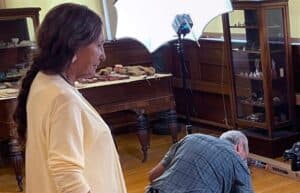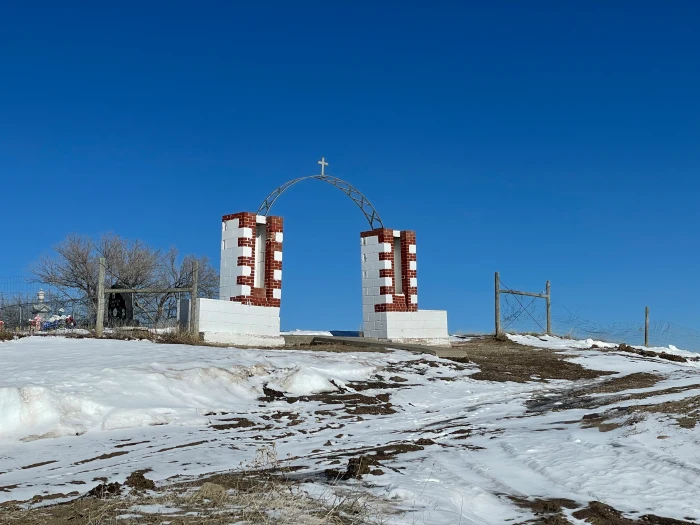With crime rates dropping, a Native lawmaker is concerned over priorities
Burn, bury or display
Tribal nations discuss how to treat stolen items from Wounded Knee victims
MaKenzie Huber
South Dakota Searchlight

FILE – Leola One Feather, left, of the Oglala Sioux Tribe in South Dakota, observes as John Willis photographs Native American artifacts on July 19, 2022, at the Founders Museum in Barre, Mass. Federal penalties have increased under a newly signed law Wednesday, Dec. 21, 2022, intended to protect the cultural patrimony of Native American tribes. (AP Photo/Philip Marcelo, File)
Cedric Broken Nose stopped his van every hundred or so miles in a cross country trek from Massachusetts to South Dakota last November.
He’d get out and circle the vehicle in an empty parking lot, smudging sacred herbs and praying as curious bystanders looked on.
The stops added hours to his two-and-a-half day journey, but it was a responsibility that came with the cargo: belongings stripped from hundreds of Lakota men, women and children killed by U.S. cavalry in the Wounded Knee massacre 133 years ago.
Broken Nose was charged with delivering the more than 130 items back home, to the Pine Ridge Reservation. The Founders Museum in Barre, Massachusetts, kept the items for nearly a century. Now, tribal citizens are beginning a series of meetings to discuss what to do with the items.
Broken Nose is the great-grandson of James Pipe On Head, who survived the massacre at 12 years old. Broken Nose said he is a descendent of Chief Big Foot as well, who died at Wounded Knee.
“Our ancestors were murdered there, but their items were taken away. As they’re taken away, their spirit is uneasy and these items need to be there so they make a full circle,” Broken Nose said.

Descendants of the Wounded Knee survivors pressured the museum for decades to return their ancestors’ items.
The Native American Graves Protection and Repatriation Act, adopted in 1990, requires government-funded institutions to acknowledge their ownership of Native human remains and sacred objects. The museum chose to return items but was not required to do so, because it is privately funded.
Tribal citizens received clothing, weapons, pipes and more.
The memory of Wounded Knee is still painful, Broken Nose said. Growing up, he returned to the site of the massacre each year on the Dec. 29 anniversary to pray with his grandmother. Descendants held a ceremony on the 2022 anniversary to officially accept the belongings.
Saturday, March 25 will be the first of four gatherings, The Si’Tanka Ta’ Oyate O’mniceye (The Ancestors’ Belongings meeting), to discuss what to do with the items — bury them, burn them or display them in a local museum — but also to pray and grieve, Broken Nose said. Citizens of the Standing Rock, Cheyenne River and Rosebud tribal nations will attend.
Broken Nose said items such as clothing, which have blood or sweat on them from their wearers, would traditionally be burned in a spiritual ceremony to be returned to the ancestor they belonged to.
Items such as pipes and tomahawks are traditionally passed down to younger family members. But since it would be difficult and costly to find what families the items belong to, the discussion will focus on where to keep and potentially display such items.
Although it has been proposed to bury items at the site, Broken Nose worries that the items could be dug up again.
“As Lakota people, we have a whole year to go through this bereavement process and then release the items like in a ceremony to release the soul,” he said, adding that future meetings will likely follow the astronomical coming of the seasons. “It helps us to grieve and let go at the end.”
This article was first published in South Dakota Searchlight.
External
Missing persons searches use drones, sonar and scent tracking dogs
Efforts to find Wesley Dixon Jones entailed new technology; coordinator plans to search again before weather worsens
The 20-year-old citizen disappeared Nov. 1
We put the question to Native community members
Indigenous designers showcased at Far North Fashion Show






